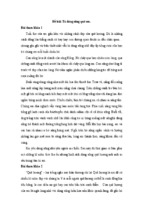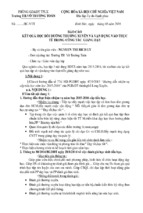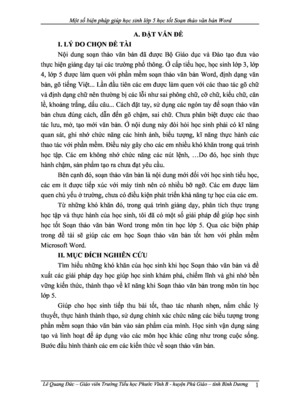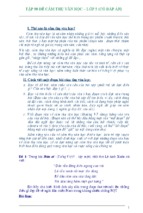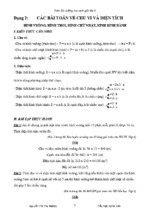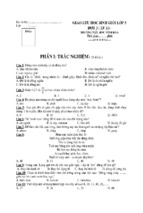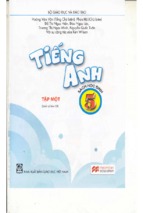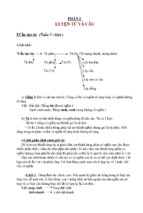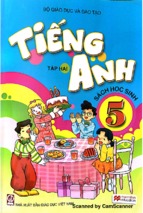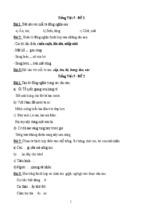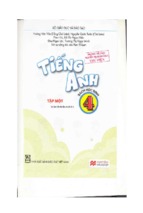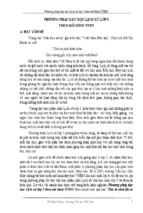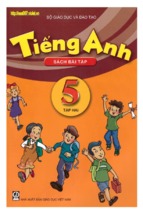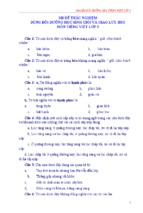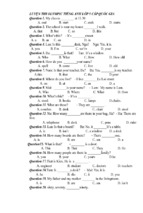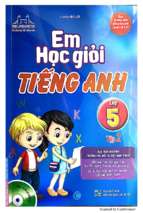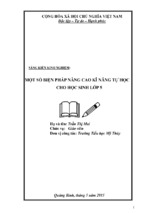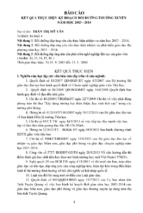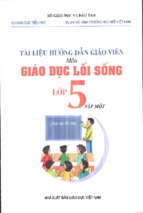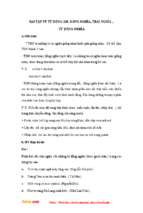Unit 11: What’s the matter with you? Lesson 2.1
Week: 19
Period: 73
Date of teaching: Monday, January 9th 2017
Teacher’s and students’ activities
Sts and T greet each other
T asks sts to sing the song
Sts sing the song.
Contents
I/ Class order:
Greeting and checking attendance
Warm up: sing What’s the
matter with you?
T introduces the new lesson and gives new
words
T reads new words a few times, sts repeat.
T asks Sts to read. T corrects their
pronunciation.
II/ New lesson:
* New words:
dentist,
take a rest
carry
sweet
T explains the model sentences then asks Sts to
translate and try to practice with their friends.
Model sentences:
A: you should go to the doctor.
B: Yes, I will. Thanks.
A: you shouldn’t carry heavy things.
B: OK, I won’t. Thanks.
Have the class look at the pictures. Introduce
the story by pointing at each character and ask
the Sts answer some questions. Play the
recording all the way through for the class to
listen and follow in their books. Play it again
for them to repeat line by line. If there is
enough time, sts can role play to say aloud.
Tell the class that they are going to practise
asking and answering the sentence patterns of
the lesson. Point at each picture and ask the
question for pupils to answer chorally. Have
pupils practise asking and answering in pairs.
Monitor the activity and offer help, if
necessary. Invite one or two pairs to speak to
check their performance.
1 Look, listen and repeat.
Mai: Where’s Nam? I can’t see him here.
Quan: He’s sitting over there, in the corner of
the gym.
Mai: Hi, Nam. Why aren’t you practising
karate?
Nam: I don’t feel well. I have a backache.
Mai: Sorry to hear that. You should go to the
doctor now, Nam
Nam: OK, I will. Thanks, Mai
Doctor: You should take a rest and shouldn’t
play sports for a few days
Nam: Thank you, doctor
2 Point and say.
a. go to the doctor
You should go to the doctor
Yes, I will. Thanks.
b. go to the dentist
You should go to the dentist
Yes, I will. Thanks.
c. take a rest
You should take a rest
Yes, I will. Thanks.
d. eat a lot of fruit
You should eat a lot of fruit
Yes, I will. Thanks.
e. carry heavy things
You shouldn’t carry heavy things
OK, I won’t. Thanks
f. eat a lot of sweets
You shouldn’t eat a lot of sweets
OK, I won’t. Thanks
Language notes:
• We can say go to the doctor/dentist or go to
the doctor’s/dentist’s.
• Pupils should say thank you/thanks when they
receive advice.
Tell the class that they are going to practise
further by asking and answering sentence
patterns of the lesson. Get pupils to work in
groups. Remind them to use the questions and
answers in their books. Set a time limit for the
class to practise. Monitor the activity and offer
help, if necessary. Invite a few pupils to repeat
their interviews to the class. Then give
feedback.
3 Let’s talk
Your friend is not well. Tell him/her what
he/she should/shouldn’t do.
I have a/an
.
You should
.
Yes, I will. Thanks.
You shouldn’t __________.
OK, __________. Thanks.
T asks Sts to focus on the structure once again
and retells the content of the lesson
III/ Consolidation:
Focusing on the structure once again.
Retelling the content of the lesson
Teacher asks Sts to learn at home and prepare
for the next part.
IV/ Assignments:
Learn the lesson by heart
Prepare for the next part
Unit 11: What’s the matter with you? Lesson 2.2
Week: 19
Period: 74
Date of teaching: Wednesday, January 12th 2017
Teacher’s and students’ activities
Sts and T greet each other
Spend a few minutes having the class revise the
story in Activity 1. Invite four pupils to act out
the story.
Contents
I/ Class order:
Greeting and checking attendance
Warm up: Activity 1
II/ New lesson:
Tell pupils that they are going to listen to the
4. Listen and complete.
recording and do the task. Play the recording all Key: 1 Quan: should go to the doctor
the way through for pupils to listen. Play it
2 Tony: shouldn’t go to school
again for them to do the task. Get them to
3 Phong: shouldn’t eat ice cream
compare their answers before checking as a
4 Mrs Green: shouldn’t carry heavy things
class. Play the recording again to confirm the
Audio script
answers. Give explanations for answers which
1. Quan: I don’t feel very well.
pupils find difficult.
Mai: What’s the matter with you?
Quan: I have a stomach ache.
Mai: Sorry to hear that. You should go to the
doctor now, Quan.
Quan: OK, I will. Thanks
2. Tony’s mother: You don’t look very well.
What’s the matter with you?
Tony: I have a fever.
Tony’s mother: Let me see. Oh, you’re
very hot. You shouldn’t go to school today.
3. Mai: Let’s have ice cream.
Nam: Great idea!
Phong: Sorry, I can’t.
Mai: What’s the matter with you, Phong?
Phong: I have a bad toothache.
Mai: Oh, then you shouldn’t eat ice cream.
How about milk?
Phong: Good idea. Thanks, Mai
4. Nam: Hi, Mrs Green. What’s the matter with
you?
Mrs Green: I have a backache.
Nam: Sorry to hear that. Oh, you shouldn’t
carry heavy things. Let me help you.
Mrs Green: Thanks, Nam. That’s very kind of
you.
Tell the class that they are going to read and do
the task. Give them a few seconds to read the
sentences. Remind them to focus on the context
to select the appropriate words. Set a time limit
for pupils to do the task independently. Monitor
the activity and offer help, if necessary. Get
5. Read and complete. Then say aloud.
Quan: Where’s Phong?
Mai: He can’t go to school today.
Quan: Why not? What’s the (1) matter with
him?
Mai: He (2) has a bad cough and is going to
them to compare their answers in pairs before
checking as a class. Sts read aloud
T tells sts that they are going to play the game.
T reminds sts how to play the game and let the
game begin. T announces the winner.
see the (3)doctor this morning.
Quan: Oh, really? Poor him!
Mai: What’s the matter with you, Tony?
Tony: I have a pain in my (4) stomach.
Mai: Oh, dear. You should take a (5) rest. now
and go to the doctor later.
Tony: Yes, I will. Thanks, Mai
6. Let’s play.
What’s the mattter with you? (Charades)
T asks Sts to focus on the structure once again
and retells the content of the lesson
III/ Consolidation:
Focusing on the structure once again.
Retelling the content of the lesson
Teacher asks Sts to learn at home and prepare
for the next part.
IV/ Assignments:
Learn the lesson by heart
Prepare for the next part
Unit 11: What’s the matter with you? Lesson 3.1
Week:19
Period: 75
Date of teaching: Thursday, January 13th 2017
Teacher’s and students’ activities
Sts and T greet each other
T spend a few minutes revising the previous
lesson by inviting some pupils to role-play the
conversations in Lesson 2, Activity 5.
Tell the class that they are going to practise
saying questions and answers with the correct
intonation.. Play the recording all the way
through for pupils to listen and follow in their
books. Then play it again for them to repeat all
the words and sentences twice.
Contents
I/ Class order:
Greeting and checking attendance
Warm up: Lesson 2, Activity 5.
II/ New lesson:
1. Listen and repeat
1. What’s the matter with you?
I have a headache. v
2. What’s the matter with you?
I have a toothache. v
3. What’s the matter with you?
I have a stomach ache v
v
v
v
Language note: Wh-questions usually have a
falling intonation, which can be marked
with an arrow like this at the end.
2. Listen and circle a or b. Then ask and
Tell pupils that they are going to listen to the
answer.
recording and do the task. Play the recording all Key: 1 b 2 b 3 a 4 a
the way through for pupils to listen. Play it
Audio script
again for them to do the task. Get them to
1. What’s the matter with you? I have a
compare their answers before checking as a
headache.
class. Play the recording again to confirm the
2. What’s the matter with you? I have a
answers. Give explanations for answers which
backache.
pupils find difficult.
3. What’s the matter with you? I have a
stomach ache.
4. What’s the matter with you? I have a pain in
my stomach.
3. Let’s chant. What’s the matter with you?
Tell the class that they are going to say the
chant. Have them read the chant and check their
comprehension. Play the recording all the way
through for pupils to listen and follow in their
books. Then play it again for them to repeat line
by line. Have them practise chanting and doing
actions in groups. Invite two or three groups to
say the chant and do actions.
T asks Sts to focus on the structure once again
and retells the content of the lesson
What’s the matter with you?
I have a toothache.
You should go to the dentist.
You shouldn’t eat lots of sweets.
What’s the matter with you?
I have a headache.
You should go to the doctor.
You shouldn’t watch too much TV
III/ Consolidation:
Focusing on the structure once again.
Retelling the content of the lesson
Teacher asks Sts to learn at home and prepare
for the next part
IV/ Assignments:
Learn the lesson by heart
Prepare for the next part
Lesson Plan
Teacher: Văn Ngọc Trân
Day: 16/1/2017
Class: 5
Unit 11: What’s the matter with you? Lesson 3.2
Week: 19
Period: 76
Date of teaching: Friday, January 16th 2017
Teacher’s and students’ activities
Sts and T greet each other
T asks sts to chant and do the actions
Tell the class that they are going to read and do
the task. Give them a few seconds to read the
sentences. Remind them to focus on the context
to select the appropriate words. Set a time limit
for pupils to do the task independently. Monitor
the activity and offer help, if necessary. Get
them to compare their answers in pairs before
checking as a class.
Contents
I/ Class order:
Greeting and checking attendance
Warm-up: chant What’s the matter with you?
II/ New lesson:
4. Read and match. Then say.
Key: 1 f 2 d 3 e 4 a 5 c 6 b
How to stay healthy
1. Wash your hands
2. Eat
3. Do
4. Brush
5. Keep your nails
6. Take
a. your teeth twice a day.
b. a shower every day.
c. short and clean.
d. healthy foods.
e. morning exercise regularly.
f. before having meals.
5. Write your advice.
Tell the class that they are going to write some
advice for the characters. Have them read the
questions and check their understanding. Set a
time limit for them to do the task. Monitor the
activity and offer help, if necessary. Get them to
swap and read their writing before inviting one
or two pupils to read their answers aloud and
give feedback.
Suggested answers:
1 Tony should brush his teeth after meals. He
shouldn’t eat ice cream.
2 Quan should keep warm. He shouldn’t go out.
3 Phong should eat healthy foods. He shouldn’t
eat too much chocolate.
4 Phong should keep warm. He shouldn’t talk
too much or eat ice cream
Tell the class that they are going to do a project. 6. Project
They should work in groups to discuss. Set a
Talk about two health problems and give
time limit for them to do the task. Invite a few
groups to present their project to the class and
talk about them. If there is not enough time,
give the activity as homework and talk about
that in the next lesson as a warm-up activity.
Have the class read the statements and check
their comprehension. Give them time to colour
the stars and invite a few pupils to read the
statements aloud. Give further support to pupils
who find it difficult to achieve certain
objectives.
T asks Sts to focus on the structure once again
and retells the content of the lesson
Teacher asks Sts to learn at home and prepare
for the next part
advice.
7. Colour the stars.
Now I can ...
• ask and answer questions about common
health problems and give advice.
• listen to and understand texts about common
health problems.
• read and understand texts about common
health problems.
• write advice on common health problems.
III/ Consolidation:
Focusing on the structure once again.
Retelling the content of the lesson
IV/ Assignments:
Learn the lesson by heart
Prepare for the next part
Lesson Plan
Teacher: Văn Ngọc Trân
Day: 17/1/2017
Class: 5
Unit 12: Don’t ride your bike too fast. Lesson 1.1
I/ Objectives:
By the end of the lesson students can:
- Asking and answering questions about possible accidents at home
- Asking and answering questions about accident prevention
II/ Language contents:
1/ Grammar:
Don’t ...! - OK, I won’t.
Why shouldn’t I ...? - Because ...
2/ Vocabularies:
knife, matches, stairs, stove, arm, leg, climb, run down, fall off, break, cut, burn
3/ Pronunciation:
Intonation
Don’t play with the knife! v
OK, I won’t. v
Why shouldn’t I play with the knife? v
Because you may cut yourself v
III/ Techniques:
Eliciting and suggestion
IV/ Teaching aids:
Pictures, text book, cassette player and lesson plan
V/ Procedures:
Week: 20
Period: 77
Date of teaching: Monday, January 17th 2017
Teacher’s and students’ activities
Sts and T greet each other
Have the class report the results of the class
health survey from Unit 11, Lesson 3,
Activity 6. Introduce the new lesson by writing
the unit title on the board and have pupils
repeat it twice.
T introduces the new lesson and gives new
words
T reads new words a few times, sts repeat.
T asks Sts to read. T corrects their
pronunciation.
T explains the model sentences then asks Sts to
Contents
I/ Class order:
Greeting and checking attendance
Warm up: Unit 11, Lesson 3,
Activity 6.
II/ New lesson:
* New words:
Knife
matches
stairs
stove
climb
run
down
cut
burn
Model sentences:
translate and try to practice with their friends.
A: Don’t play with matches
B: OK. I won’t.
Have the class look at the pictures. Introduce
the story by pointing at each character and ask
the Sts answer some questions. Play the
recording all the way through for the class to
listen and follow in their books. Play it again
for them to repeat line by line. If there is
enough time, sts can role play to say aloud.
1. Look, listen and repeat.
Tom: What are you doing, Mary?
Mary: I’m cutting the cabbage
Tom: Don’t play with the knife! You may cut
yourself.
Mary: OK
Tom: What are you doing with the stove?
Mary: I want to cook the cabbage.
Tom: Don’t touch the stove!
You may get a burn.
OK, I won’t.
Tell the class that they are going to practise
asking and answering the sentence patterns of
the lesson. Point at each picture and ask the
question for pupils to answer chorally. Have
pupils practise asking and answering in pairs.
Monitor the activity and offer help, if
necessary. Invite one or two pairs to speak to
check their performance.
2. Point and say
a. play with matches
Don’t play with matches
OK, I won’t.
b. ride your bike too fast
Don’t ride your bike too fast
OK, I won’t.
c. climb the tree
Don’t climb the tree
OK, I won’t.
d. run down the stairs
Don’t run down the stairs
OK, I won’t.
Tell the class that they are going to practise
further by asking and answering sentence
patterns of the lesson. Get pupils to work in
groups. Remind them to use the questions and
answers in their books. Set a time limit for the
class to practise. Monitor the activity and offer
help, if necessary. Invite a few pupils to repeat
their interviews to the class. Then give
feedback.
3. Let’s talk.
Ask and answer questions about accidents at
home and give advice.
What are you doing
?
I want to
Don’t
OK, I won’t.
T asks Sts to focus on the structure once again
and retells the content of the lesson
III/ Consolidation:
Focusing on the structure once again.
Retelling the content of the lesson
Teacher asks Sts to learn at home and prepare
for the next part.
IV/ Assignments:
Learn the lesson by heart
Prepare for the next part
Lesson Plan
Teacher: Văn Ngọc Trân
Day: 18/1/2017
Class: 5
Unit 12: Don’t ride your bike too fast. Lesson 1.2
Week: 20
Period: 78
Date of teaching: Wednesday, January 18th 2017
Teacher’s and students’ activities
Sts and T greet each other
T spends a few minutes revising the previous
lesson by inviting one or two pairs of pupils to
talk about accidents at home and give advice in
front of the class, using Don’t ...! and OK, I
won’t
Contents
I/ Class order:
Greeting and checking attendance
Warm up: Revising the last lesson
II/ New lesson:
4. Listen and tick.
Tell pupils that they are going to listen to the
recording and do the task. Play the recording all Key: 1 b 2 c 3 a 4 b
Audio script
the way through for pupils to listen. Play it
1. Mother: What are you doing with the knife,
again for them to do the task. Get them to
Mary?
compare their answers before checking as a
Mary: I’m cutting the fruit.
class. Play the recording again to confirm the
Mother: Don’t play with the sharp knife! You
answers. Give explanations for answers which
may cut yourself!
pupils find difficult.
Mary: OK, I won’t, Mum.
2. Phong: I’m going to run down the stairs.
Tom: Don’t do it!
Phong: Why not?
Tom: It’s dangerous.
Phong: OK.
3. Linda: Hey, Trung. Where are you going?
Trung: I’m riding to the sports centre.
Linda: Don’t ride your bike too fast!
Trung: Don’t worry. I won’t.
4. Mai: What are you doing here, Nam?
Nam: Look. I’m going to climb the tree to pick
some apples.
Mai: Don’t climb the tree!
Nam: OK, I won’t.
Tell the class that they are going to read and do
the task. Give them a few seconds to read the
sentences. Remind them to focus on the context
to select the appropriate words. Set a time limit
for pupils to do the task independently. Monitor
the activity and offer help, if necessary. Get
5. Read and complete.
One day, Peter was bored. He was in his (1)
room and his mother
was (2) cooking in the kitchen. She asked
loudly “Where are you,
Peter?” He (3)answered, “I’m upstairs, Mum.”
His mother heard him
them to compare their answers in pairs before
checking as a class.
Tell the class that they are going to sing a song.
Have them read the lyrics and teach the
unfamiliar words. Check comprehension. Play
the recording all the way through for pupils to
listen and follow in their books. Play it again
for them to repeat line by line. When the class
are familiar with the melody, ask them to sing
along with the music before having them
practise singing and doing actions in groups.
Invite a group to sing the song and do actions.
running down and said “Don’t (4) run down the
stairs!” Peter
replied “OK, I (5) won’t do it again, Mum.”
6. Let’s sing.
Don’t do that!
What are you doing?
I’m going to run down the stairs.
Don’t do that! It’s dangerous.
Really? Yes! OK, I won’t.
What are you doing?
I’m going to climb that tree over there.
Don’t do that! It’s dangerous.
Really? Yes! OK, I won’t.
What are you doing?
I’m going to ride my bike down this busy road.
Don’t do that! It’s dangerous.
Really? Yes! OK, I won’t.
T asks Sts to focus on the structure once again
and retells the content of the lesson
III/ Consolidation:
Focusing on the structure once again.
Retelling the content of the lesson
Teacher asks Sts to learn at home and prepare
for the next part.
IV/ Assignments:
Learn the lesson by heart
Prepare for the next part
Lesson Plan
Teacher: Văn Ngọc Trân
Day: 19/1/2017
Class: 5
Unit 12: Don’t ride your bike too fast. Lesson 2.1
Week: 20
Period: 79
Date of teaching: Thursday, January 19th 2017
Teacher’s and students’ activities
Sts and T greet each other
T asks sts to sing the song
Sts sing the song.
T introduces the new lesson and gives new
words
T reads new words a few times, sts repeat.
T asks Sts to read. T corrects their
pronunciation.
Contents
I/ Class order:
Greeting and checking attendance
Warm up: Let’s sing: Don’t do that!
II/ New lesson:
* New words:
arm
leg
Model sentences:
T explains the model sentences then asks Sts to A: Why shouldn’t I play with the knife?
translate and try to practice with their friends.
B: Because you may cut yourself
Have the class look at the pictures. Introduce
the story by pointing at each character and ask
the Sts answer some questions. Play the
recording all the way through for the class to
listen and follow in their books. Play it again
for them to repeat line by line. If there is
enough time, sts can role play to say aloud.
Tell the class that they are going to practise
asking and answering the sentence patterns of
the lesson. Point at each picture and ask the
question for pupils to answer chorally. Have
pupils practise asking and answering in pairs.
Monitor the activity and offer help, if
necessary. Invite one or two pairs to speak to
check their performance.
1. Look, listen and repeat.
Look. What are these
children doing, class?
They’re looking at the apples on the tree
What is this boy doing?
He’s climbing the apple tree.
Should he do that?
No, he shouldn’t.
Why shouldn’t he climb the tree?
Because he may fall
and break his leg.
2. Point and say.
a. play with the knife/
Why shouldn’t I play with the knife
Because you may cut yourself
b. play with the stove/ get a burn
Why shouldn’t I play with the stove
Because you may get a burn
c. ride too fast/ fall off your bike
Why shouldn’t I ride too fast
Because you may fall off your bike
d. run down the stairs/ break your arm
Why shouldn’t I run down the stairs
Because you may break your arm
Tell the class that they are going to practise
further by asking and answering sentence
patterns of the lesson. Get pupils to work in
groups. Remind them to use the questions and
answers in their books. Set a time limit for the
class to practise. Monitor the activity and offer
help, if necessary. Invite a few pupils to repeat
their interviews to the class. Then give
feedback.
3. Let’s talk.
Ask and answer questions about why someone
shouldn’t do something.
What is he/she doing?
He/She is __________.
He/She shouldn’t do that!
Why shouldn’t he/she …?
Because he/she may __________.
T asks Sts to focus on the structure once again
and retells the content of the lesson
III/ Consolidation:
Focusing on the structure once again.
Retelling the content of the lesson
Teacher asks Sts to learn at home and prepare
for the next part.
IV/ Assignments:
Learn the lesson by heart
Prepare for the next part
Lesson Plan
Teacher: Văn Ngọc Trân
Day: 20/1/2017
Class: 5
Unit 12: Don’t ride your bike too fast. Lesson 2.2
Week: 20
Period: 80
Date of teaching: Friday, January 20th 2017
Teacher’s and students’ activities
Sts and T greet each other
T spends a few minutes revising the previous
lesson by inviting a few pairs of pupils to act
out
the story in Activity 1.
Contents
I/ Class order:
Greeting and checking attendance
Warm up: Activity 1.
II/ New lesson:
4. Listen and complete with one word.
Key: 1 sharp 2 wall 3 burn 4 arm
Tell pupils that they are going to listen to the
recording and do the task. Play the recording all Audio script
1. Mother: You shouldn’t use that knife!
the way through for pupils to listen. Play it
Tony: Why not?
again for them to do the task. Get them to
Mother: Because it’s very sharp.
compare their answers before checking as a
Tony: OK, Mum. Sorry.
class. Play the recording again to confirm the
2. Linda: Hey, Nam. You shouldn’t climb the
answers. Give explanations for answers which
wall!
pupils find difficult.
Nam:Why not?
Linda: Because you may fall and break your
leg.
Nam: OK, I won’t.
3. Peter: You shouldn’t play with the stove,
Mai.
Mai: Why not?
Peter: Because you may get a burn.
Mai: Right. Thank you, Peter.
4. Linda: Tom, don’t ride too fast!
Tom: Why not?
Linda: Because you may fall off your bike and
break your arm.
Tom: OK. I’ll slow down.
Tell the class that they are going to read and do
the task. Give them a few seconds to read the
sentences. Remind them to focus on the context
to select the appropriate words. Set a time limit
for pupils to do the task independently. Monitor
the activity and offer help, if necessary. Get
them to compare their answers in pairs before
checking as a class.
5. Read and complete.
Tom: What are you holding in your hand?
Phong: A (1) knife
Tom: Oh, no. It’s dangerous. (2) Don’t play
with it!
Phong: (3) Why shouldn’t I play with it?
Tom: Because you may cut (4) yourself.
Phong: I can (5) see that. Thank you, Tom.
6. Let’s play.
T tells sts that they are going to play the game.
T reminds sts how to play the game and let the
game begin. T announces the winner.
T asks Sts to focus on the structure once again
and retells the content of the lesson
III/ Consolidation:
Focusing on the structure once again.
Retelling the content of the lesson
Teacher asks Sts to learn at home and prepare
for the next part.
IV/ Assignments:
Learn the lesson by heart
Prepare for the next part
Lesson Plan
Teacher: Văn Ngọc Trân
Day: 6/2/2017
Class: 5
Unit 12: Don’t ride your bike too fast. Lesson 3.1
Week: 21
Period: 81
Date of teaching: Monday, February 6th 2017
Teacher’s and students’ activities
Sts and T greet each other
T spends a few minutes revising the previous
lesson by having the class play Spelling bee
with
words such as: don’t, play, ride, knife, stove,
should, shouldn’t, because, may and fall. At the
end of the
game, have them make sentences with Don’t ...
and Because ..
Tell the class that they are going to practise
saying sentences with falling intonation. Play
the recording all the way through for pupils to
listen and follow in their books. Then play it
again for them to repeat all the sentences twice.
Contents
I/ Class order:
Greeting and checking attendance
Warm up: game: Spelling bee
II/ New lesson:
1. Listen and repeat
1. Don’t play with the knife! v
OK, I won’t.
2. Don’t play with matches.
OK, I won’t.
3. Why shouldn’t I play with the knife?
Because you may cut yourself.
4. Why shouldn’t I play with the stove?
Because you may get a burn.
2. Listen and circle a or b. Then say the
sentences aloud.
Tell pupils that they are going to listen to the
recording and do the task. Play the recording all Key: 1 a 2 a 3 b 4 b
Audio script
the way through for pupils to listen. Play it
1. Don’t play with the knife!
again for them to do the task. Get them to
2. Don’t climb the wall!
compare their answers before checking as a
3. Why shouldn’t he ride his motorbike too
class. Play the recording again to confirm the
fast?
answers. Give explanations for answers which
4. Why shouldn’t she play with the stove?
pupils find difficult.
3. Let’s chant
Why shouldn’t he do that?
Tell the class that they are going to say the
chant. Have them read the chant and check their Look at Jim.
What’s he doing?
comprehension. Play the recording all the way
He’s riding his bike too fast.
through for pupils to listen and follow in their
books. Then play it again for them to repeat line Should he ride it too fast?
by line. Have them practise chanting and doing No, he shouldn’t.
actions in groups. Invite two or three groups to Why not?
He may fall off his bike.
say the chant and do actions.
Look at Mary.
What’s she doing?
She’s playing with a cat on the street.
Should she play with the cat?
No, she shouldn’t.
Why not?
It may scratch her face
T asks Sts to focus on the structure once again
and retells the content of the lesson
Teacher asks Sts to learn at home and prepare
for the next part
III/ Consolidation:
Focusing on the structure once again.
Retelling the content of the lesson
IV/ Assignments:
Learn the lesson by heart
Prepare for the next part
Lesson Plan
Teacher: Văn Ngọc Trân
Day: 8/2/2017
Class: 5
Unit 12: Don’t ride your bike too fast. Lesson 3.2
Week: 21
Period: 82
Date of teaching: Wednesday, February 8th 2017
Teacher’s and students’ activities
Sts and T greet each other
T asks sts to chant and do the actions
Tell the class that they are going to read and do
the task. Give them a few seconds to read the
sentences. Remind them to focus on the context
to select the appropriate words. Set a time limit
for pupils to do the task independently. Monitor
the activity and offer help, if necessary. Get
them to compare their answers in pairs before
checking as a class.
Tell the class that they are going to write
sentences about accidents that may happen to
Tony, Linda and Quan.. Have them read the
questions and check their understanding. Set a
time limit for them to do the task. Monitor the
Contents
I/ Class order:
Greeting and checking attendance
Warm up: chant Why shouldn’t he do that?
II/ New lesson:
4. Read and do the tasks.
1. Circle the best title
Key: b
a. Common accidents
c. How to be safe at home
b. Preventing children from falling
Falling is a common type of accident for young
children at home. Your
baby brother or sister may fall off a bed or a
sofa. He or she may also fall
down the stairs. The following tips can help to
keep your baby brother or
sister safe:
• Make sure he or she can’t roll off the bed.
• Make sure he or she can’t open any windows.
• Don’t let him or her go near the stairs.
• Don’t let him or her out on the balcony.
2. Tick True (T) or False (F).
Key: 1 T 2 F 3 T 4 F 5 F
1. Babies may roll off a sofa.
2. You shouldn’t stop your baby brother or
sister when he
or she climbs the stairs.
3. You should make sure he or she can’t roll off
the bed.
4. Do not open any windows at home.
5. Allow him or her to play on the balcony
alone sometimes
5. Write what may happen.
1. Tony’s playing with a sharp knife. He may
cut himself
2. Linda’s playing with a neighbour’s cat. It
may scratch her face
3. Quan’s riding his bike too fast. He may fall
activity and offer help, if necessary. Get them to off his bike and break his arm
swap and read their writing before inviting one
or two pupils to read their answers aloud and
give feedback.
6. Project
Tell the class that they are going to do a project. Make a poster about home accidents and how
They should work in groups to discuss. Set a
to avoid them.
time limit for them to do the task. Invite a few
groups to present their project to the class and
talk about them. If there is not enough time,
give the activity as homework and talk about
that in the next lesson as a warm-up activity.
7. Colour the stars.
Now I can ...
Have the class read the statements and check
ask and answer questions about preventing
their comprehension. Give them time to colour accidents at home.
the stars and invite a few pupils to read the
listen to and understand texts about preventing
statements aloud. Give further support to pupils accidents at home.
who find it difficult to achieve certain
read and understand texts about preventing
objectives.
accidents at home.
write about possible accidents.
T asks Sts to focus on the structure once again
and retells the content of the lesson
III/ Consolidation:
Focusing on the structure once again.
Retelling the content of the lesson
Teacher asks Sts to learn at home and prepare
for the next part
IV/ Assignments:
Learn the lesson by heart
Prepare for the next part
- Xem thêm -

